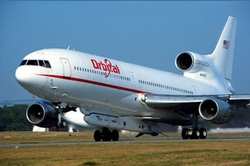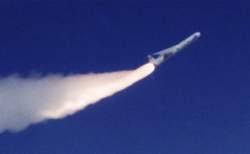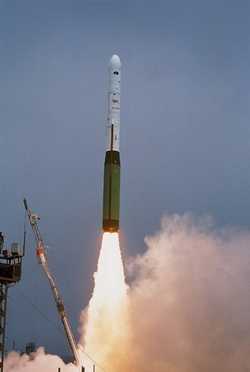Fri, Jan 24, 2003
Wins $60 Million in New Small Launch Vehicle Orders
 Orbital Sciences Corporation has received firm
orders for four small space launch vehicles from the U.S.
Government. At the end of 2002, the National Aeronautics and Space
Administration (NASA) contracted with the company to launch its
Spectroscopy and Photometry of the Intergalactic Medium's Diffuse
Radiation (SPIDR) satellite aboard the company's Pegasus rocket in
a mission that will take place in 2005.
Orbital Sciences Corporation has received firm
orders for four small space launch vehicles from the U.S.
Government. At the end of 2002, the National Aeronautics and Space
Administration (NASA) contracted with the company to launch its
Spectroscopy and Photometry of the Intergalactic Medium's Diffuse
Radiation (SPIDR) satellite aboard the company's Pegasus rocket in
a mission that will take place in 2005.
Separately, the U.S. Department of Defense (DoD) contracted with
the company for three Minotaur space launch vehicles under the U.S.
Air Force's Orbital/Suborbital (OSP)-1 program. One of the Minotaur
vehicles will be used for the Department of Defense's Near-Field
Infrared Experiment (NFIRE) mission and the other two vehicles will
be used for missions to be announced by the DoD at a later date.
Together, the four firm orders total approximately $60 million in
value.
 The missions will be executed by Orbital beginning
in 2003 and will be completed over the next several years. The
company did not disclose the financial terms of the individual
missions.
The missions will be executed by Orbital beginning
in 2003 and will be completed over the next several years. The
company did not disclose the financial terms of the individual
missions.
Mr. David W. Thompson, Orbital's Chairman and Chief Executive
Officer, said, "As the world's preeminent supplier of small launch
vehicles, we are very pleased with the continued strong demand for
our family of small launchers and booster rockets. We are very
grateful for the confidence our customers have in our launch
vehicle products and believe it is well placed. Our company is
totally committed to continuing our outstanding reliability record
in support of our customers' important missions."
About Pegasus
 Orbital's Pegasus rocket is the world's only small
space launch vehicle that has been certified with NASA's Payload
Risk Category 3, which the space agency reserves for its highest
value space missions.
Orbital's Pegasus rocket is the world's only small
space launch vehicle that has been certified with NASA's Payload
Risk Category 3, which the space agency reserves for its highest
value space missions.
With the SPIDR contract, NASA has now awarded Orbital 6 of up to
16 potential missions under Kennedy Space Center's Small Expendable
Launch Vehicle Services agreement.
About Minotaur
 Orbital developed the ground-launched four-stage
Minotaur rocket for the U.S. Air Force's Orbital/Suborbital
Program. The vehicle uses U.S. Government-supplied Minuteman II
motors that have been decommissioned as a result of arms reduction
treaties, with the deactivated rocket motors serving as the
vehicle's first and second stages. Its third and fourth stages, as
well as its guidance and control system, use technology from the
company's Pegasus rocket.
Orbital developed the ground-launched four-stage
Minotaur rocket for the U.S. Air Force's Orbital/Suborbital
Program. The vehicle uses U.S. Government-supplied Minuteman II
motors that have been decommissioned as a result of arms reduction
treaties, with the deactivated rocket motors serving as the
vehicle's first and second stages. Its third and fourth stages, as
well as its guidance and control system, use technology from the
company's Pegasus rocket.
The NFIRE mission to be flown on a Minotaur rocket in 2004 is
sponsored by the U.S. Missile Defense Agency through the Air Force
Space and Missile Systems Center's Rocket Systems Launch Program.
The satellite is designed to evaluate technologies for boost-phase
missile defense.
More News
Minimum Sector Altitude The lowest altitude which may be used under emergency conditions which will provide a minimum clearance of 300 m (1,000 feet) above all obstacles located in>[...]
Aero Linx: African Civil Aviation Commission (AFCAC) At AFCAC, our Safety Strategic Objective is to enhance Aviation Safety and the efficiency of Air Navigation Services in Africa.>[...]
The Local Controller’s Poor Judgment In Prioritization Of Their Ground Traffic Ahead Of Their Airborne Traffic Analysis: Hawaiian Airlines flight 70 (HAL70), N2165HA, an Airb>[...]
Get The Latest in Aviation News NOW on Instagram Are you on Instagram yet? It's been around for a few years, quietly picking up traction mostly thanks to everybody's new obsession >[...]
Also: Beech M-346N, Metro Gains H160 EMS STC, New Bell Boss, Affordable Flying Expo Tickets NOW On Sale! Purdue University’s Research Foundation and the Archaeological Legacy>[...]
 ANN's Daily Aero-Term (10.31.25): Minimum Sector Altitude [ICAO]
ANN's Daily Aero-Term (10.31.25): Minimum Sector Altitude [ICAO] ANN's Daily Aero-Linx (10.31.25)
ANN's Daily Aero-Linx (10.31.25) NTSB Final Report: Airbus A321-271N (A1); Cessna 172N (A2)
NTSB Final Report: Airbus A321-271N (A1); Cessna 172N (A2) ANN FAQ: Follow Us On Instagram!
ANN FAQ: Follow Us On Instagram! Airborne 10.30.25: Earhart Search, SpaceX Speed Limit, Welcome Back, Xyla!
Airborne 10.30.25: Earhart Search, SpaceX Speed Limit, Welcome Back, Xyla!






